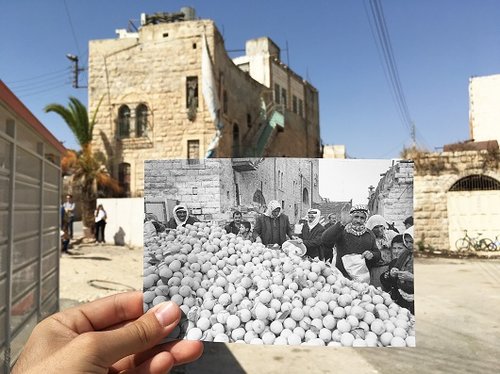A Photographic Perspective: What Happened to Hebron in 50 Years of Occupation?
The security situation has turned Hebron's bustling city center into a ghost town. Nearly 2,000 shops and businesses were closed and thousands of people were left without a source of income. How did it happen?

לקריאת הכתבה בעברית|لقراءة المقال بالعربيه
November 1972.For years, Hebron was a mixed city in which Jews and Muslims lived. After the Arab riots of 1929, Hebron’s Jews were forcibly evacuated. Settlers returned to the city after the Six-Day War of 1967, attracting majorJewish businesses like Tnuva. In 1970 a large settlement called Kiryat Arba was built adjacent to the city, and the settlers who had been in Hebron moved there, So that in 1972, Hebron was again empty of Jews. It was the largest Palestinian city in the West Bank, with a huge commercial center. Several large markets operated there in parallel – the fruit and vegetable market, the meat market, the spice market and the gold market, all located on Shuhada Street, the city’s main long thoroughfare. Despite the occupation, the street was bustling and full of people – even the settlers shopped there.

October 2017.In 1979, a group of settlers sneaked into a house in the city, under the nose of the Israel Defense Forces. The government decided not to evacuate them, thereby renewing settlement in the city. Tension between Jews and Arabs heightened after the First Intifada, reaching its peak with the 1994 massacre of Arabs at the Tomb of the Patriarchs, called Ma’arat Hamachpela in Hebrew. Israel and the Palestinian Authority divided the city, imposing severe restrictions of movement on the 850 settlers and mainly on the 200,000 Palestinians, who are not allowed to travel on Shuhada Street. The once-bustling commercial center turned into a ghost city. Almost 2,000 businesses closed, the market stands were covered in dust, thousands of people were left without a source of income. Palestinians who remained in their homes around the street were trapped inside as metal cages closed their porches and entrance doors were welded shut. Found on the street today are soldiers on patrol, settlers calling out their praise and observers from a variety of organizations including Breaking the Silence, which seeks to tell the story of the long occupation and the price paid by the Palestinians. And also by the society that sends its young people to enforce this reality.
Original photo: Moshe Milner
